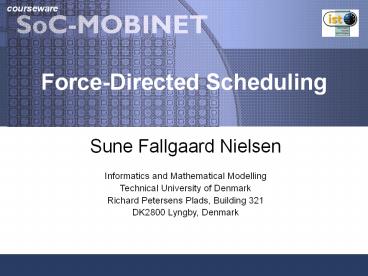Force-Directed Scheduling PowerPoint PPT Presentation
Title: Force-Directed Scheduling
1
Force-Directed Scheduling
Sune Fallgaard Nielsen Informatics and
Mathematical Modelling Technical University of
Denmark Richard Petersens Plads, Building
321 DK2800 Lyngby, Denmark
2
Overview / Agenda
- Motivation
- Introduction
- Defining problem and model
- Solution
- Results
- Conclussion
3
Motivation
- The mapping from a behavioral model to a physical
Register-Transfer level description is a
NP-complete problem. - Therefore an exhaustive comparison on all
possible solutions is infeasible. - An algorithm finding an efficient mapping is
required.
4
Introduction
- The paper was written in 1989.
- The interest on High-Level Languages like VHDL is
increasing at that time. - Synthesis tools capable of generating a RTL
realization from a behavioral model is needed.
5
Introduction
6
Introduction
7
Defining problem and model
- The problem
- For a given function, find an optimal solution.
An optimal solution can be constrainted by area-,
power-, performance- or flexibility requirements
depending on the application. - The model
- Scheduling Determine for each operation the
time at which it should be performed without
violating any precedence contraints.
8
Solution
- Common Approach New Approach
- List Scheduling Force-Directed Scheduling
- Resources given Time contraints given
- Minimize delay Minimize required resources
9
Solution
- Common Approach New Approach
- List Scheduling Force-Directed Scheduling
- Resources given Time contraints given
- Minimize delay Minimize required resources
10
Force-Directed Scheduling
- The Force-Directed Scheduling approach
- reduces the amount of
- Functional Units
- Registers
- Interconnect
- This is achieved by balancing the concurrency of
operations to ensure a high utilization of each
unit.
11
Force-Directed Scheduling
- The Force-Directed Scheduling algorithm consists
of 3 steps - Determine a time frame of each operation
- Create a distribution graph
- Calculate the force (a new metric)
12
Scheduling An example
- Solve the differential equation
- y 3zy 3y 0
- This can be calculated using this iterative
algorithm - while(z lt a) repeat
- zl z dz
- ul u (3 z u dz) (3 y dz)
- yl y (u dz)
- z zl
- u ul
- y yl
13
Scheduling An example
- Data-Flow and Control-Flow Graphs
- ASAP Scheduling ALAP Scheduling
14
Scheduling An example
- Data-Flow and Control-Flow Graphs
- ASAP Scheduling ALAP Scheduling
15
Scheduling An example
Step 1 Determine a time frame of each operation
Error in Figure
16
Scheduling An example
Step 2 Create a distribution graph
DG(1) 2.833 DG(3) 0.833 DG(2) 2.333 DG(4)
0
17
Scheduling An example
Step 3 Calculate the force (a new metric)
A metric called force is introduced. The force is
used to optimize the utilization of units. A
high positive force value indicates a poor
utilization.
18
Scheduling An example
Step 3 Calculate the force (a new metric)
Free
Fixed
19
Scheduling An example
Step 3 Calculate the force (a new metric) With
the operation x in control-step 1.
Poor utilization
DG(1) 2.833 DG(3) 0.833 DG(2) 2.333 DG(4)
0
20
Scheduling An example
Step 3 Calculate the force (a new metric) With
the operation x in control-step 2. (x must be
in control-step 3)
Direct force (calculated as before)
Indirect force (on x in control-step 3)
Good utilization
DG(1) 2.833 DG(3) 0.833 DG(2) 2.333 DG(4)
0
21
Scheduling An example
By repeatedly assigning operations to various
control-steps and calculating the force
associated with the choice several force values
will be available. The Force-directed scheduling
algorithm chooses the assignment with the lowest
force value, which also balances the concurrency
of operations most efficiently.
22
Force-Directed Scheduling
- The Force-Directed Scheduling approach
- reduces the amount of
- Functional Units
- Registers
- Interconnect
By introducing Registers and Interconnect as
storage operations, the force is calcuted for
these as well. The 3 steps of the algorithm are
carried out for these operations also.
23
Force-Directed Scheduling
24
Force-Directed Scheduling
Introducing Registers and Interconnect as
operations.
Since the Registers and Interconnect area
consumption is reduced in solution b, it might
be optimal.
25
Force-Directed List Scheduling
- List Scheduling Force Directed Scheduling
- Resources given Time contraints given
- Minimize delay Minimize required resources
- If the problem is the other way around, ie. if
the resources are - given a Force-Directed List Scheduling algorithm
can be applied.
26
Force-Directed List Scheduling
- The Force-Directed List Scheduling utilizes the
- strengths of the
- Force-Directed Scheduling and
- List Scheduling
Force-Directed List Scheduling is similar to List
Scheduling except force is the priority
function, not mobility.
27
Force-Directed List Scheduling
List Scheduling Force-Directed List
Scheduling
Force is a better metric
Mobility is a poor metric
We have 1 adder and 1 multiplier
28
Results
Test Application Fifth-order Elliptic Wave
Filter
Many optimal results, depending on the application
One result, ASAP is not optimal.
xp is a pipelined multiplier
29
Results The Design Space
The Force-Directed List Scheduling gives better
means for exploring the design space. It offers
many results and depending on the application the
designer can choose to use more or less resources
and see what implications it will have on the
delay.
30
One more optimization
The Force-Directed List Scheduling is implemented
in a system called HAL. HAL also uses techniques
called register merging and multiplexer
merging. These techniques minimizes the cost on
registers and interconnections.
31
Results
Comparison on various syntesis tools normalized
to HAL86 Test Application Differential Equation
Non-pipelined Multiplier
Pipelined Multiplier
32
Results
Physical unit and interconnection requirements
Test Application Wave Filter
33
Conclussions
- The Force-Directed Scheduling and Force-Directed
List - Scheduling algorithms allows the designer to
explore the - design space.
- By taking into account the cost of
interconnection, registers - and multiplexers a more precise algorithm is
realized. - The HAL system, using these algorithms, shows
promising - results compared to other systems.

